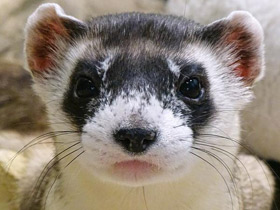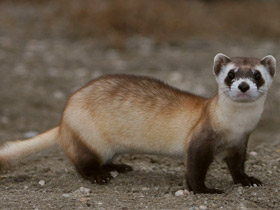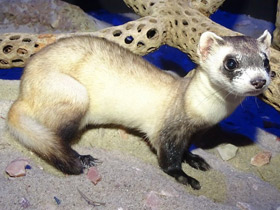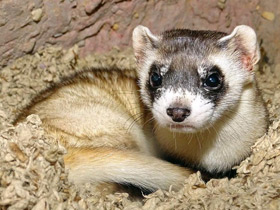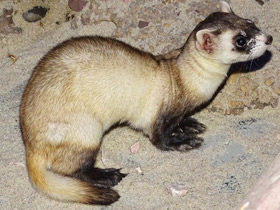The black-footed ferret (Mustela nigripes), also known as the American polecat or prairie dog hunter
The black-footed ferret (Mustela nigripes), also known as the American polecat or prairie dog hunter, is a species of mustelid native to central North America.
The black-footed ferret is roughly the size of a mink and is similar in appearance to the European polecat and the Asian steppe polecat. It is largely nocturnal and solitary, except when breeding or raising litters. Up to 90% of its diet is composed of prairie dogs.
Habitat and appearance
Mustela nigripes is a species of carnivorous mammal. It is a member of the diverse mustelid family which includes weasels, minks, polecats, martens, otters, and badgers. It is closely related to Mustela eversmanii of Russia.
Mustela nigripes was originally distributed in the eastern and southern regions of the Rocky Mountains, across the Great Plains from Alberta and Saskatchewan, to Texas and Arizona (USA). It is usually found in grasslands with low to medium grass cover, forming the same association as the meadow spiny dogfish. It is a secretive animal, leading a mainly nocturnal lifestyle. It has well-developed senses: acute hearing, acute sense of smell and good eyesight.
Mustela nigripes has a long neck and a slender, wiry body with very short legs. Its smooth coat is yellowish in colour, and has black spots on the muzzle, the tip of the tail and the legs are also black. Mustela nigella is between 46 and 60 cm long, of which 13-15 cm is the tail; its weight varies between 0.7 and 1.1 kg (males are slightly heavier than females).
On the ground, Mustela nigripes move at a jump or slow gallop (up to 8-11 km/h), and can travel up to 10 km in one night. Ferrets usually live 3-4 years in the wild (the oldest lived at least 8 years) and 8-9 years in captivity (the oldest was at least 11 years old).
Lifestyle and peculiarities
Mustela nigripes is a very talkative animal. It screams loudly when disturbed, frightened or excited. In such a situation, it emits several loud screeches, interrupted by low hissing notes. Male Mustela nigripes "giggle" when in contact with a female during the mating period, and the young emit very quiet squeaks.
Like other weasels and ferrets, Mustela nigripes are constantly moving around their territory, which is about 1-2 km in diameter. In search of prey, it even rises to the top of mountains in a non-forested area. Individuals have been found up to 3,000 m above sea level, and another was found drowned in Moreno Lake, Colorado, USA, at 3,125 m. On cold and snowy days, it stays in a burrow, feeding on its stores.
Nutrition
Mustela nigripes is usually found in colonies of grasshoppers, which make up the absolute majority of its diet (up to 90%). This predator also feeds on moles, other small rodents, American rabbits and birds. It has been estimated that 40-60 hectares of prairie dog colonies are needed to maintain a black-footed ferret. Around these colonies it rests and sleeps, obtains its food, avoids predators, avoids bad weather and suckles its young.
Reproduction
Outside the breeding season, Mustela nigripes leads a solitary lifestyle. To communicate with conspecifics, it uses scent markers: it marks the boundaries of its territory with secretions from its ananas glands.
The breeding season of Mustela nigripes is March-April. Pregnancy lasts 41-45 days, the female gives birth to 3-4 young. When they mature, she leaves them alone in the nest during the day and hunts for them herself. The male does not participate in the rearing of the young. The young begin to hunt alone in September and October. Young males disperse from their nest over considerable distances (10-15 km), while females remain close to their mother's territory. Young Mustela nigripes reach sexual maturity in their first year of life and breed until they are 3-4 years old.
Conservation status
Mustela nigripes is listed in the International Red Data Book as endangered. Between 1996 and 2004, the species was considered extinct in the wild. The ferret is now found in Canada and the United States. The population of the species in 2005 was about 500 in the wild and about 1,000 in captivity.
The main threat to Mustela nigripes is habitat loss (conversion of fields and grasslands for agricultural use and a widespread eradication programme have reduced the black-footed ferret's habitat to less than 2% of what it once was).

















